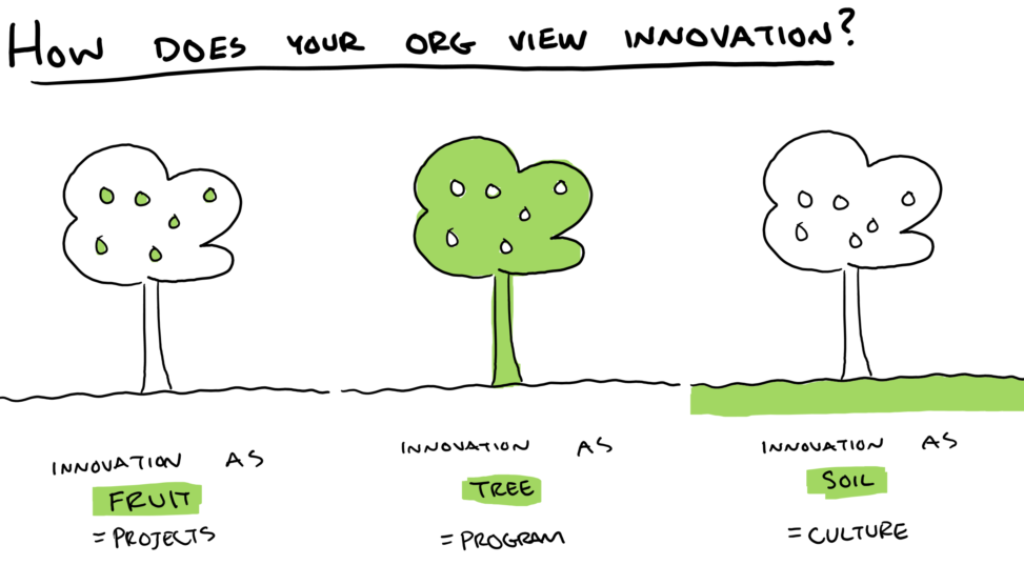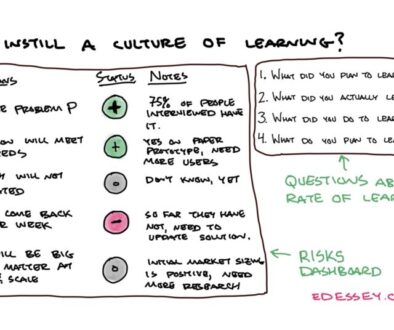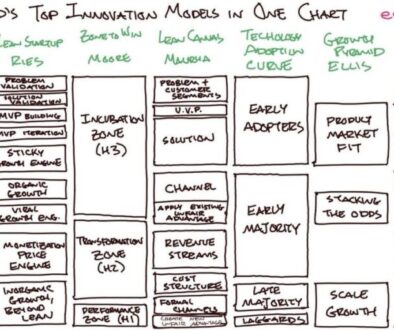How to Unlock Your Innovation Growth with Fruits, Trees, and Soil
If you’re an innovation leader in your organization, you’ve come to the right place. This is the post that ignited this site.
Through my work, I’m lucky to meet many of the rare people who lead innovation programs. Since you’re so rare, you’re hard to find. Leaders like you have various job titles, exotic program names, and different terminology, and that makes finding you tough.
Whether you run a lab, studio, incubator, skunkworks, innovation program, or any of an infinite variety of edgy metaphors, I’d bet money that when you find somebody else with a job like yours, you feel like you’ve met your soul mate. You bond over so many common success stories and common challenges. Yet (yet!) you get the sinking feeling you might not understand what they’re doing at all.
Fruits, Trees, and Soil
Once, while giving a tour to around 30 innovation leaders from various companies, it struck me that we don’t have a shared way of talking about what we’re doing. Everyone was asking probing questions that didn’t make sense to swaths of the room. Then, the fruits, trees, and soil metaphor came to me on the spot, and it resonated with the group. Since then, it has helped me get on the same page with many other innovation leaders. I hope it resonates with you, too.
Like the 6 blind men with different perspectives on an elephant, innovation leaders perceive innovation from their angle. It’s easy to see only a part of the whole ecosystem. Then with the right perspective, things click into place. For innovation, the main difference is whether you think of innovation as fruits, as trees, or as soil.

First, let’s take a look at innovation as a fruit, which, until recently, was the most common perspective.
Fruit
Most enterprises charter an innovation leader to produce innovations like they’re fruit. “I need you to deliver an innovation this year.” Then, if you don’t deliver the new business, your program or even your career is at risk.
Other companies give you a different charter.
Tree
You may be asked to create innovation as if it’s a sustainable tree. “Please create a program that can bring a bunch of new stuff to market quickly.” It’s fascinating to watch these programs learn to produce better and better fruit. It’s also very fun (and hectic!) to run them.
If this is you, and you’re still around years after founding, you probably got strong top-down support and an early win, maybe even in your first batch. It’s unclear how much of that’s luck–what’s referred to as a purple patch. However, if you’re that leader, you’re able to attribute credit to your skills and build on that win. Then, you can quickly operate at a profit, and often bring more–but smaller–successes to market. (And they are often smaller in the next batch because it’s natural to regress to the mean from an outlier.)
A focus on trees is typically not sustainable, either. Since producing a great fruit is a rare event. So, you’re most lucky if you can focus on an even more fundamental level.
Soil
For instance, other programs–like the Microsoft Garage, where I work–aren’t chartered to produce fruit nor grow a tree.
Instead, these teams are asked to change the company to a culture that’s ripe for innovation. That’s soil. When you create soil, you create the fertile ground to plant the seeds of new ideas. This is a great position to be in. You’re afforded the patience and foresight to invest in a culture that can sustain long term corporate growth. At times I’ve found it a luxury, but now I see it as the most sustainable and reliable way to do this. It requires enlightened management to do this.
As you enrich the soil, you see trees grow and then bear fruit. You can enable every person and team across the company to plant the seeds of their ideas into culturally fertile ground. Once that soil is rich, you’re in a sustainable position to produce more and more yield.
But, even if you’re set up to focus innovation like a fruit or a tree, there’s still benefit to focusing on the soil.
The Benefits of Soil
If you’ve been viewing your innovation program as a tree or fruit, you may have neglected your soil. Here’s a little story from the Microsoft Garage, where I work.
For the last 5 years, the Microsoft Garage has run the largest private Hackathon on the planet. It grows each year in practically every dimension.
Every Hackathon produces thousands of seeds–this is an enormous source of projects. Now we’re building the programs to nurture those into fruit-bearing trees. Over time, our focus on the soil, and operating differently has led to more skilled hackers, as I noted in What I Learned Watching All 1800 Pitches from Microsoft’s Giant Hackathon.
They’re not just entry-level hackers anymore. They’re laddering up their projects to what’s good for business, what’s good for the world, and what’s good for customers. They’re getting better at finding the tools that they need to operate fast and try things. They’ve gotten better at finding more diverse teams, and thus team formation is easier. They are learning, building, and measuring faster.
I hear from my peers at other companies that “team formation” is one of the biggest challenges that they face. That surprised me the first time I heard it. I rarely see that problem in the Garage. I credit that to the investment already made in the soil. Essentially, our culture has been addressing it for years: the hackers know how to find each other, our staff knows how to make matches, and our tooling makes this straight-forward.
Getting healthier soil pays off just as much as getting better at trees and fruit. That’s why it’s important to balance your investments, and not neglect any part of your innovation ecosystem.
A Portfolio Approach
Using this metaphor as a framework helps you take a portfolio approach to capability development in your organization. As you invest in your organization, you can balance your investments across soil, fruit, and trees.
For soil, you can improve at cultural transformation, change management, policy change, providing air cover, and other related skills.
As a tree, you get better at understanding your business, managing your portfolio and resources, improving project selection, forming strong teams, and coaching them.
And for your focus on fruit, you improve at growth hacking, lean startup, making great products, going to market, and building new businesses.
It’s important to balance investments in these areas to have a well-rounded program. And it helps to learn from others who have done this before.
Finding Our Guild
If you’re like the other innovation leaders I’ve met, you probably have a lot of questions, but no source of answers. That’s because folks like us are rare. But now, we’re getting better at finding each other, and we’re increasingly less rare as more organizations fund our programs.
If you’re an innovation leader, I’m sharing this to reach and aid you. Please introduce yourself.
Also, if you know someone who would like this, please introduce me. If we bring together the soil tillers, tree growers, and fruit farmers, we can be a guild that elevates the whole industry.
That’s my goal. I want to bring us together to share what we learn and raise the whole craft. That’s what a guild does for its members. We need each other.
The credit for the fruit, trees, and soil metaphor goes to Rick Barraza, who originally used it in the context of Design and Creativity. Thank you, Rick!
Note: I previously published this article on LinkedIn.




The World's Top Innovation Models in One Chart - Ed Essey
May 15, 2020 @ 5:08 am
[…] This week I was honored to speak at the Innov8rs community event Connect: Business Design & Venture Building. It featured a great group of folks around the world. In my talk, I built on some of the stuff that I’ve already written about here like How to Create Pathways for Innovation in Your Organization, The Challenges and Strengths of Corporation Incubation, and How to Unlock Innovation Growth with Fruit, Trees, and Soil. […]